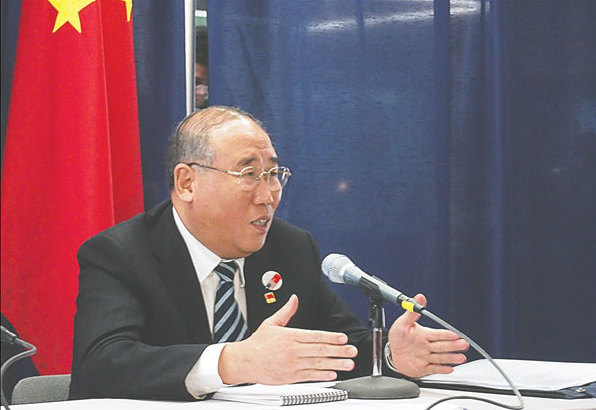China, US cut a new deal on greenhouse gas emissions
|
Xie Zhenhua speaks at the China-US Strategic and Economic Dialogue on Wednesday. Chen Weihua / China Daily |
China and the United States have made another major bit of progress in cooperating on climate change, just a month after an agreement by their presidents to phase out hydrofluorocarbons (HFCs), potent greenhouse gases.
The two countries agreed to five new action initiatives with the goal of cutting greenhouse gas emissions and air pollutants by tackling the largest sources of emissions in both countries.
These include reducing emissions from heavy-duty vehicles, increasing carbon capture, utilization and storage (CCUS), increasing energy efficiency in building, industry and transport, improving greenhouse gas data collection and management, and promoting smart grids, according to a US State Department statement.
Xie Zhenhua, deputy director of the National Development and Reform Commission and co-chair of the China-US working group on climate change, described the new initiatives on climate change between the two countries as a new highlight of their bilateral relationship.
"But both countries still have a lot to do," he told reporters shortly after the conclusion of a small-scale climate change talk held after the opening ceremonies of the 5th China-US Strategic and Economic Dialogue (S&ED) in Washington.
The four co-chairs of the S&ED - Chinese Vice-Premier Wang Yang, State Councilor Yang Jiechi, US Secretary of State John Kerry and Secretary of Treasury Jack Lew - all attended the talk and applauded the report presented by the working group, which had been set up in April.
"We [China and the US]," Xie said, "are the largest developed country and largest developing country, as well as the largest greenhouse gas emitters. Strengthening our cooperation in climate change will benefit not only the people in our two countries, but all of mankind."
"We should continue such cooperation," he added.
These initiatives, and others the working group will develop, demonstrate the commitment of both countries to combat climate change and complement domestic efforts, including President Obama's recently announced Climate Action Plan, according to the State Department.
The working group will develop an implementation plan for the five action initiatives by October of this year.
Heavy-duty vehicles are the fastest growing source of greenhouse gas emissions from transportation in the US and they account for more than half of transportation fuel consumed in China. Light-duty vehicles also contribute to marked greenhouse gas emissions, fuel use and air pollution.
Under the initiatives, the two countries will make efforts to advance comprehensive policies to reduce carbon dioxide and black carbon emissions by raising fuel efficiency standards, using cleaner fuels and vehicle emissions control technologies, as well as more efficient and clean freight.
China and the US account for more than 40 percent of global coal consumption, the initiative to increase CCUS will enable the two countries to significantly reduce emissions from coal combustion in power plants and throughout the industrial sector.
Xie said the working group will push to implement the agreement on HFCs, which he said requires both bilateral and multilateral efforts. China and the US are the two largest HFC producers and consumers.
"The key is to find a safe and low cost alternative that can effectively solve the problem," he said.
Deborah Deligsogn, a researcher at University of California at San Diego, said there is a sense of renewed momentum for bilateral cooperation on climate and energy.
"With new leadership in China and new environmental pressures, climate and environmental issues are high on the domestic agenda," she said.
Deligsogn said the two countries have a lot of reasons to work together, not only in terms of shared challenge. "We have complementary strength. There is a lot of technology we can learn from each other," she said.
China and the US have also agreed to try for a multilateral agreement on climate change by 2015.
Xie said an ideal agreement would reflect the principle of common but differentiated responsibilities.
"It should be a fair and reasonable agreement that is acceptable to all and one that reflects the pace and level of a country's development. And China will play a constructive role towards achieving the goal," he said.
While major progress has been made in the climate change sector, an energy security talk, also a new addition to the S&ED agenda and presided over by the four co-chairs on Wednesday, discussed a wide range of topics, including the exchange of shale gas technology, data transparency, renewable energy, clean coal technology, securing safe transport from major oilfields and investment and trade in future energy.
Zhang Yuqing, deputy director of the National Energy Administration, said the talks will play a positive role in helping US companies invest in China, including in nonconventional resources such as shale gas, and Chinese companies' investment in the energy sector of the US.
Sarah Forbes, a senior associate at the World Resources Institute, said shale gas is an area of a lot of certainty and also a great area for cooperation.
"The US-China collaboration will first benefit energy security. Cooperation between US and China will unlock shale gas in China," she said.
"We need to find a global smart way to develop shale gas," Forbes said.
chenweihua@chinadailyusa.com



















